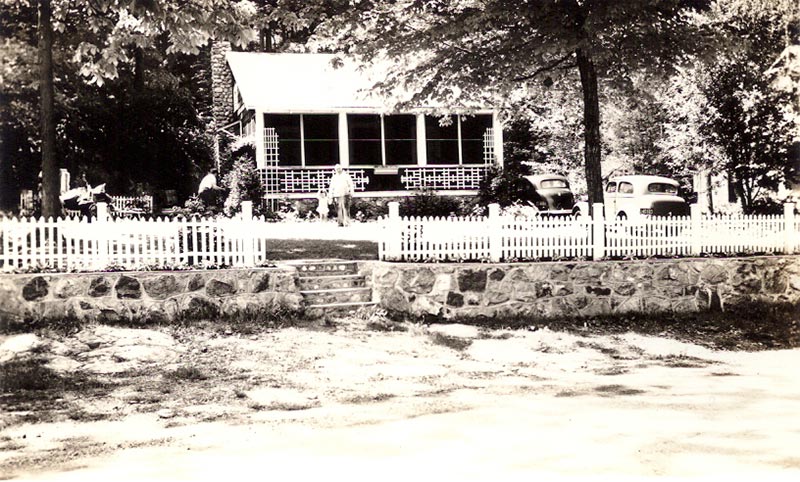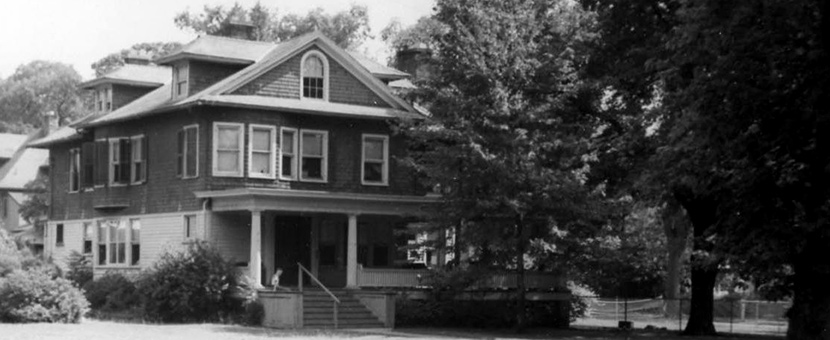Open House at 124 Shoreham Road, Shoreham!
“You guessed it,” replied their father. “This is our street, Shoreham Road. Our number is 124.”
“And there’s our house,” shouted Pam. “I know it from the picture the real-estate man sent.”
Nestled far back from the road was the Hollisters’ new home. It was a large, three-story house. Big lawns stretched away on either side. The lake touched the property in the rear.
This is the description of the home of The Happy Hollisters from the very first volume of the series. Many readers have speculated about Shoreham’s “real” location, and dreamed of visiting the town and touring the home where the Happy Hollisters lived. Was it on the north side of Long Island? Or in Vermont, along the shore of Lake Champlain? Or somewhere else??
In truth, the fictional house at “124 Shoreham Road” was probably a mash-up of two very real places in the life of author Jerry West (a pseudonym for Andrew Svenson). The Svenson family home on Church Street in Bloomfield, NJ, was an idyllic place to grow up: an imposing, three-story house, perfect for inspiring ghost stories and mysteries. The sweeping lawn provided additional space for the children’s adventures, especially when Andrew needed quiet time inside for writing!
“Pine Lake” is as fictional as Shoreham, but was probably inspired by summers the Svenson family spent at Lake Lackawanna, in Sussex County, NJ. Andrew Svenson’s parents owned a home there, which sat on the north side of the lake. Eventually Andrew and his wife Marian purchased their own home on the opposite shore, providing an additional backdrop for many happy memories and adventures (as well as a few mishaps!) which found their way into The Happy Hollisters’ stories.
 Gram’s House
Gram’s House
Lake Lackawanna
In 1953, the year the first Happy Hollisters volume was published, Andrew’s daughter Laura (the inspiration for Pam Hollister) wrote an essay about visiting her grandparents’ home at Lake Lackawanna. It offers a charming peek into her past, complete with the sounds and smells of childhood adventures. If you could put their Bloomfield house on the shores of Lake Lackawanna, and see it through Laura’s memories, you’d probably have a pretty good picture of the Happy Hollisters’ home. You may never able to tour the actual house, but this essay, along with the photos above, give a good idea of how the house at 124 Shoreham Road came to life!
Gram’s House
Ever since I can remember, a trip to “the Lake” to visit my grandmother had been an occasion joyfully anticipated by my brothers and sisters and me. These infrequent forty-mile journeys generally occurred during the summer, and when my father would suddenly announce that we were going to the Lake, everyone hurried to make ready. Bathing suits had to be gathered together, food had to be packed. Gram could never feed eight people in a surprise attack. Clothes had to be changed from dresses and trousers to dungarees. At last we would be off, packed into the car along with boxes of the aforementioned essentials. Even the baby knew something was happening.
“Lake?” she would beam. “We go Lake?”
From then on it was a matter of time until we spotted landmarks which told us our destination was near: under the cement bridge, past the house with the fountain on the lawn, around the traffic circle, then, after a bend in the road, a large white house.
“The Crash-up House!” six voices would shout at once. This place, so named because we once saw an automobile accident there, marked the turn into a narrow dirt road leading to the Lake.
The summer heat softened the tar-topped road and loosened pebbles imbedded in the surface. Whenever the car swerved onto the shoulder, little stones pinged against the fender as they spun off the tires. It was always quiet along that road, the gentle, warm, fresh-smelling quiet of a summer day in the country. On either side stretched woods of slender trees and straggling brush that invited adventurous children to come and play. Beyond the woods rose the low mountains of the Kittatinny range, a patchwork of greens with an occasional boulder standing out.
At last the final bend in the road and we would all strain to catch the first glimpse of the Lake. There! There it was! First, a small cove bordered by tall, waving rushes and cattails. A red-winged blackbird used to have her nest in them. On the opposite side of the inlet, a huge rock sloped into the water, an excellent place for sunning turtles and children. Many times I have lain there, soaking up the afternoon sun with no one near but a hard-shelled reptile, watching through sun-squinted eyes the undulating vegetation and darting water bugs. This inlet was the best place for fishing; the largest and wiliest bass lurked over by the shore where the arched birch trees tried to bend and touch the water.
The cove widened into the main Lake, lying deeply sapphire and sparkling under the high, high summer sky. A breeze excited the little waves, which lapped at the docks and the weather-beaten rowboats beside them. Along the shore were small, trim cottages, while here and there a larger, more elaborate house appeared. At the end of the Lake, jutting out over the water, was Jack’s Pavilion. The log edifice, with its red roof and screened porches was set off by a parking area of blindingly white pebbles which crunched under the wheels of cars. Jack, the friendly, white-haired proprietor, knew what I always wanted: a strawberry ice cream cone dipped in bits of chocolate. Then while my father did his purchasing, I would wander about the room, fascinated by the rows and rows of magazines and comic books, the penny candy case, the fishing trophies and the occasional glimpses of the back room, the bar. From that room issued raucous laughter, juke box tunes, the stale smell of beer, and the staccato sound of pin-ball machines. I was duly impressed by it all.
The best thing about the Lake, of course, was Gram’s house. The brown-shingled bungalow, tinged with silver from long standing, was set on an emerald lawn and bordered with rose, phlox and cosmos. From under the low red roof peeked two small windows, from which one could see the moonlit Lake at night if one were fortunate enough to sleep on the old cot in the attic. Stretched across the front of the house was a screened porch, where we ate, slept and spent most of our time inside. It was cool and sheltered there, and while we viewed the entire Lake from it, no passerby could see us through the weathered screens.
Inside, the small house gave off a faint, but distinct “Lake smell,” a mixture of damp wood, long dead fires in the fireplace, past autumns and new springs. The peculiar odor permeated everything – the pillows on the sofa, the furniture, the beds, the curtains, the air – and I loved it. In the rear of the cottage was a narrow kitchen with an old black coal cookstove dominating one wall. Nothing tasted better than hot, juicy meats, light brown sour-apple pies or baked beans cooked all day on a coal stove!
The back porch opened onto a tiny porch which house a large, green, wooden icebox. Inside the deep chest was always something good to eat – quarts of cool milk, big pats of pale, moist butter and strawberry jam to spread on homemade bread, ripe succulent tomatoes, or, if Gram were expecting us, several containers of ice cream. The lid was heavy, but two of us usually managed to hold it open for inspection. A few feet from the porch the mountain began its steep incline. I remember gazing up at the mass of tall trees, gigantic boulders, remnants of a glacial period, and vague, black shadows which towered mysteriously over the inhabitants of the valley.
Around the side of the house was a clearing where the old rusty swing creaked comfortably. We spent hours on that swing, pretending it was a ship at sea, and rocking and rolling until we had reached a far-off destination or tired our feet with pushing. Roses climbed the ten-foot rock behind the swing. We often followed the flowers’ clambering example, though why no one ever fell down from that high perch, I do not know. Next to the house was a green pump which, after much priming, gave forth the sweetest, clearest, coldest water I have ever tasted. Before dinner the sound of the pump handle could be heard drawing a pitcher of the liquid. Squee-e-k, thump! Squee-e-k, thump! Beside the pump rose the fieldstone chimney for the large fireplace inside. Sparrows found room for their nests here and there among the leaves of ivy.
Gram’s house is at the Lake no longer, for my kindly, gray-haired grandmother has died and her house has been sold. I visited it once afterwards. The new owner has painted and modernized the house, has taken away the flowers and the old swing. But I will always remember the Lake and “Gram’s house” as they were when I was a child.
— Laura Svenson, April 1953

